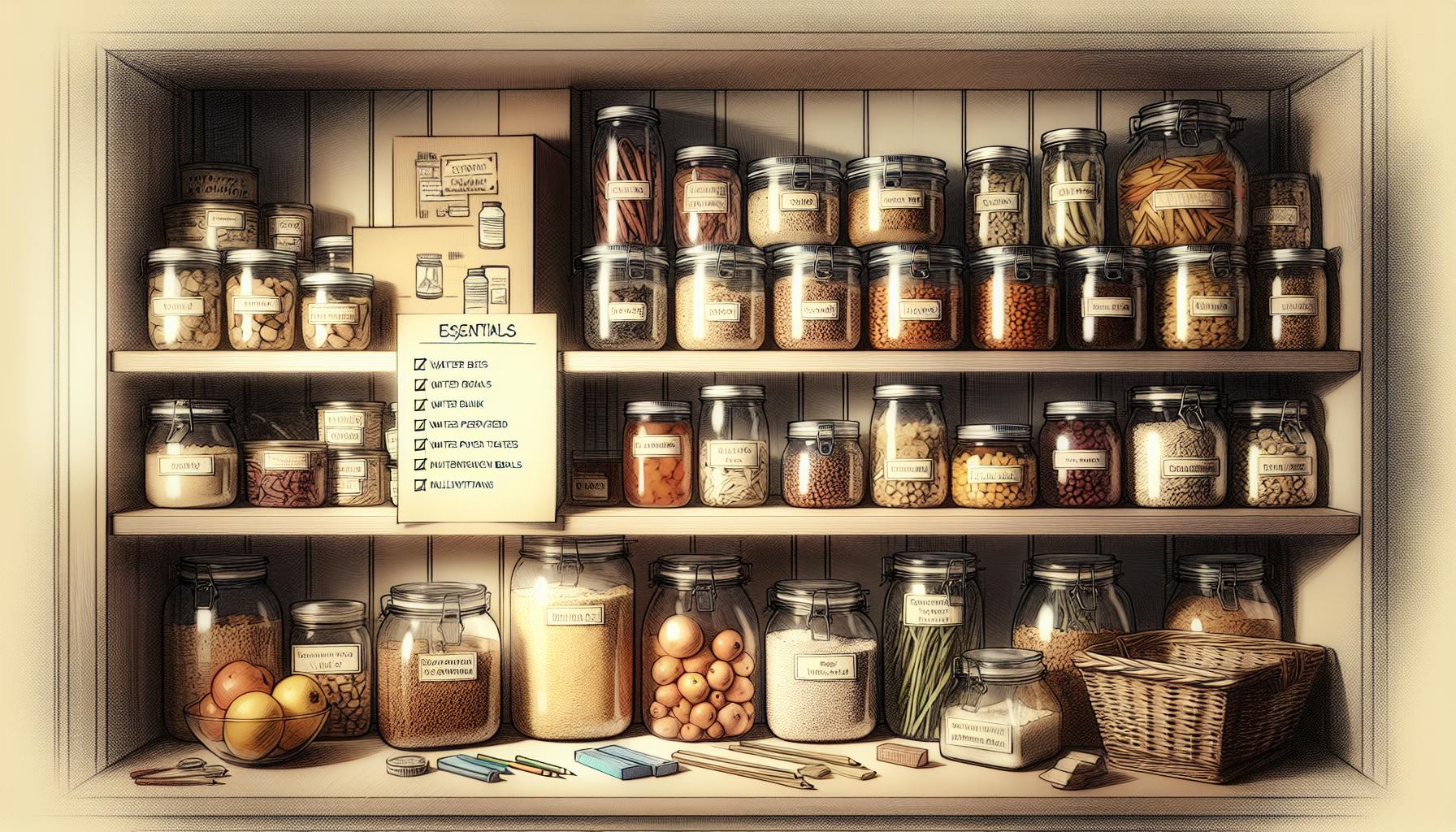When it comes to prepping, most will agree that having long term food storage is vital for survival.
By learning the essentials for stockpiling nutritious, stable foods, you can build a resilient pantry to feed your family in any crisis.
In this comprehensive guide, you'll discover the optimum containers, foods, and preservation strategies to implement robust long term food storage for when SHTF.
Introduction to Prepper Long Term Food Storage Essentials
Long term food storage is an essential part of any prepper's plans. Having a reserve of shelf-stable foods ensures you and your family will have enough to eat if stores close or supply chains are disrupted during an emergency.
The Role of Long Term Food Storage in Prepper Planning
Long term food storage serves as your food security safety net in a crisis. Whether due to natural disasters, economic collapse, or civil unrest, having nutritious foods stockpiled guarantees access to calories and nutrients if grocery stores are unavailable. A well-rounded long term food storage plan accounts for nutritional needs over an extended duration, providing the foundation for your preparedness efforts.
Advantages of a Well-Managed Food Reserve
Maintaining adequate food reserves has multiple advantages beyond just emergency preparedness:
- Provides peace of mind knowing you have food security even if paychecks stop coming
- Allows you to save money by buying many items in bulk quantities at lower unit prices
- Enables rotation of stock so nothing expires or goes to waste
- Lets you build reserves over time without pressure or urgency
- Gives you bartering items that will be in high demand during a crisis
- Allows you to help others in need when stores run bare
The key is sticking to a plan and budget so your food storage grows in a sustainable way.
How do you store food long-term for prepping?
Storing food long-term for prepping emergencies requires careful planning and preparation. Here is an effective approach:
Buy Bulk Staples
Stock up on shelf-stable basics like rice, beans, pasta, oats, and flour. These basics have long shelf lives and provide carbohydrates, protein, and fiber. Consider adding salt, sugar, corn starch, vinegar for preservation.
Build Up Canned Goods
Gradually increase your supply of canned goods like soup, vegetables, and beans until you have enough to last 2 weeks to a month. Canned goods stay fresh for years and require no special storage.
Purchase Commercial Storage Foods
From camping stores, purchase freeze-dried or air-dried foods that come in pouches or buckets. These DIY long term food storage options are nutritionally balanced, lightweight, and have 20-30 year shelf lives.
When buying for long-term food storage, focus on nutritional balance and caloric density. Having a variety of proteins, fruits, vegetables, grains, and legumes is ideal for emergencies. Track inventory with a comprehensive list noting expiration dates.
Use food-grade buckets, Mylar bags, oxygen absorbers, and sealers to safely store bulk items for decades. Rotate stock as you use it. With the right supplies and system, you can be fully prepared with long term prepper food storage when SHTF.
What are the longest lasting foods for preppers?
When building your long-term food storage, focusing on shelf-stable items with a long shelf life is key. Here are some of the longest lasting food essentials for preppers:
- Pasta and grains: Pasta, rice, oats, and other grains can last up to 30 years when properly stored. Pasta is a prepper favorite since it's affordable, nutritious, and versatile. White rice has an almost indefinite shelf life.
- Beans and legumes: Dried beans and legumes are packed with protein and fiber. They can last 10+ years when stored in airtight containers. Chickpeas, kidney beans, and lentils are great options.
- Canned goods: Properly canned goods like fruits, vegetables, soups, and meats can last 2-5 years. Opt for low-sodium and low-sugar varieties.
- Honey: With its antibacterial properties, honey is known as the only food that never spoils. Store honey in an airtight container.
- Sugar and salt: White granulated sugar and salt can both last indefinitely. They help preserve other foods and provide calories.
- Vinegar: An opened bottle of vinegar will remain usable for about 2 years. Unopened, it can last over 5 years. The acetic acid acts as a preservative.
- Oils: Vegetable, coconut, and olive oils can keep for 2-3 years if stored properly. Oils last longer when cool, dark, and in airtight containers.
Focus on nutrition density in addition to shelf life when stocking up. Include some vitamin-rich foods like nuts, powdered milk, dried fruit, and nut butters for balanced prepper meals.
What is the best way to preserve food for long-term storage?
Preserving food for long-term storage is essential for preppers to build a robust pantry. The best methods include:
Dehydrating
Dehydrating removes moisture from foods which prevents spoilage. You can use an electric dehydrator, oven, or even the sun with a solar dehydrator. Dehydrate fruits, vegetables, meats, and herbs.
Canning
The canning process kills bacteria through heat and seals food in air-tight jars or cans. Canned goods like soups, meats, fruits and vegetables can last 1-5 years when stored properly. Look for BPA-free cans.
Vacuum Sealing
Using a vacuum sealer to remove air from bags or containers of food eliminates oxygen that causes deterioration. Vacuum seal rice, beans, pasta, coffee, and more in moisture-proof bags.
Freezing
Freezing stops bacteria growth so foods like meat, baked goods, fruits and veggies can be preserved 6-12 months. Use chest freezers if possible since they maintain temperatures better during a power outage.
When it comes to long term food storage, the key is removing moisture and oxygen while keeping out light, heat, and pests. Integrate several methods like dehydrating, vacuum sealing, and cool dark storage to build a diverse prepper pantry that will sustain your family when SHTF.
How do you store food for the longest shelf life?
Properly storing food is crucial for longevity. Here are some key tips:
- Use food-grade plastic buckets or Mylar bags. Ensure they have an oxygen absorber to remove oxygen and prevent spoilage. Seal tightly.
- Store in a cool, dark, and dry place. A basement, root cellar, or pantry works well. Temperature should remain between 40-70°F.
- Rice, beans, pasta, oats, wheat, and other grains can last 20+ years if stored properly with oxygen absorbers.
- Rotate your stock. Use and replace items before they expire. "First in, first out" organization helps.
- Powdered milk can last 10-20 years. Freeze-dried and dehydrated foods may last even longer.
- Avoid temperature fluctuations. Don't store food near heat sources or appliances.
With proper storage methods, most dried goods can remain fresh for years. Investing in good containers and oxygen absorbers ensures you can rely on your food stockpile when needed.
sbb-itb-b932644
Selecting the Best Containers for Long Term Food Storage
When selecting containers for long term food storage, there are a few key criteria to consider to best preserve your food supplies over time:
Criteria for Selecting Long Term Food Storage Containers
- Airtight seal - Containers must have a reliable, air-tight seal to prevent oxygen from getting in. Oxygen causes food to spoil more quickly.
- Durable material - Look for sturdy materials like high-density polyethylene plastic, glass, or stainless steel that won't easily crack or break. Avoid containers prone to becoming brittle.
- Opaque - Opaque, non-see-through materials help block out light that can diminish nutrients and flavor.
- Food-grade - Ensure any plastic containers are BPA-free and approved for direct food contact. Look for the recycle codes 2, 4, and 5.
- Rodent-proof - Well-sealed containers prevent rodents from getting into your food storage.
The Advantages of Mylar Bags and Oxygen Absorbers
Mylar bags provide an impermeable barrier to oxygen and moisture when properly sealed. Pairing them with oxygen absorbers removes remaining oxygen from the bag, drastically increasing shelf life. Mylar bags are also lightweight, allowing for compact storage.
Potential downsides are they can be prone to punctures and tears if not carefully handled. Be sure to store them in plastic buckets or other rigid containers for protection.
Utilizing Food-Grade Buckets and Gamma Lids
Food-grade plastic buckets with snap-on gamma lids make excellent protective storage vessels. They are impenetrable to light, air and pests. The rounded shape allows efficient storage. Gamma lids provide easy access without fully removing the lid.
When storing bulk ingredients like grains, beans or cornmeal, line the buckets first with Mylar bags and oxygen absorbers before adding the food for maximum freshness.
Glass Jars and Vacuum Sealing for Longevity
For non-bulk items like spices, nuts or dehydrated fruits and vegetables, glass jars and vacuum sealers help remove oxygen for increased shelf life. Look for wide-mouth jars with rubber gaskets and clamps for the best seal.
After filling jars, use a vacuum sealer attachment to suck out excess air before sealing. This prevents oxidation and nutrient loss over time.
Properly storing food is key to building an well-stocked, long-lasting emergency pantry. Investing in quality containers tailored to your specific storage needs helps ensure you have ample reserves when you need them most.
Comprehensive Long Term Food Storage List
Creating a robust long term food storage list is essential for preppers looking to build a well-stocked pantry. When compiling your list, focus on shelf-stable items that provide nutritional balance across carbs, protein, fats, vitamins and minerals.
Essential Grains and Legumes for Sustenance
- Rice - white, brown, wild, basmati, jasmine
- Wheat - whole berries, flour, pasta
- Oats - rolled, steel cut
- Beans - pinto, black, garbanzo, kidney
- Lentils
Rice, wheat, oats and legumes offer ample carbs and plant-based protein for energy and muscle health. Opt for whole grain whenever possible. Store in airtight containers.
Vital Spices and Condiments: Salt, Sugar, and More
- Salt
- Sugar - white, brown
- Corn starch
- Vinegar - white, apple cider
Seasonings like salt, sugar, corn starch and vinegar significantly boost flavor and aid in food preservation. Store in cool, dark spaces to maintain freshness.
Nutrition-Packed Freeze-Dried and Canned Foods
Incorporate freeze-dried fruits, vegetables, meats and canned fish for added variety and nutrients like vitamins A, C, D and omega-3s. Canned goods boast a long shelf life, while freeze dried foods are lightweight and rehydrate well.
The Role of Fats and Oils in a Balanced Diet
Having cooking oil on hand provides vital calories and supports general health:
- Olive oil - for dressings and low-heat cooking
- Coconut oil - high heat tolerance makes it excellent for frying
- Vegetable, canola or sunflower oil
Look for cold-pressed, unrefined varieties with tight lids to prevent rancidity. Rotate cooking oils to avoid degradation over time.
Creating a comprehensive long term food storage list with items like grains, legumes, spices, canned goods and oil establishes the foundation for robust emergency preparedness. Stock up on these essentials in bulk for nutritious, shelf-stable sustenance when SHTF.
DIY Long Term Food Storage Solutions
Creating your own long term food storage allows you to customize your prepper pantry in an affordable way. There are various techniques for preserving foods at home to extend shelf life.
Home Preservation Techniques: Dehydrating and Canning
Dehydrating fruits, vegetables, and meats removes moisture to prevent spoilage. Follow these steps:
- Invest in a food dehydrator or oven-safe racks. Arrange food in single layers.
- Dehydrate at 130-140°F for vegetables, 125°F for fruits. Time varies.
- Check food and rotate trays periodically until completely dried.
- Store in airtight containers. Add oxygen absorbers to help removal moisture.
Canning also removes oxygen and seals in nutrients.
- Sterilize mason jars and lids. Use a water bath or pressure canner.
- Pack chopped foods tightly into jars, allowing 1⁄2 inch of headspace. Wipe rims clean.
- Process jars in the canner based on ingredients and altitude.
Building a Root Cellar: Natural Food Preservation
Root cellars leverage cool ground temperature for storage. Considerations:
- Location should be about 40-60°F year-round. Under a porch often works well.
- Good drainage, ventilation, and insulation are key. Use gravel, vapor barriers, etc.
- Store vegetables, fruits, eggs, cured meats at appropriate temperatures.
- Check regularly for spoilage. Use oldest ingredients first.
Repurposing Common Household Items for Storage
Reuse household materials for inexpensive, airtight storage:
- Clean and dry glass jars, plastic containers, coffee cans. Add oxygen absorbers.
- Use food-grade buckets with gamma seal lids. Add Mylar bags.
- Wrap bricks of cheese or butter in parchment, then foil. Freeze.
Making Your Own Mylar Bag Packages
Mylar bags help block moisture and oxygen. Create your own:
- Buy Mylar material and oxygen absorbers in bulk online. Cut sheets to size.
- Fold into bags and seal 2 sides with iron on lowest setting. Do not overheat.
- Add oxygen absorbers and food. Use clamps or tape to seal.
- Label contents and date. Store in cool, dark place.
Focusing on home preservation, root cellars, and DIY storage materials allows preppers to create affordable and custom long term food storage solutions.
LDS Food Storage Principles for Preppers
Understanding the LDS Approach to Food Storage
The Latter-Day Saints (LDS) church recommends having a three-month supply of food storage as part of their preparedness teachings. This includes having basic foods like grains, legumes, powdered milk, and salt on hand to sustain a family during an emergency.
The LDS philosophy emphasizes building self-reliance and being prepared for adversity. Food storage is seen as a practical way to care for yourself and your family during difficult times. Their teachings provide guidance on the types and amounts of food that are recommended.
Many preppers follow LDS principles for food storage as they offer time-tested wisdom on storing nutritious, shelf-stable foods. Applying these guidelines can help create a well-rounded prepper pantry.
Implementing a Three-Month Supply Strategy
The LDS church advises having a three-month supply of basic foods that provide 2,000 calories per day per person in your household. When building your supply, focus on shelf-stable items like:
- Whole grains: wheat, rice, oats, corn
- Legumes: beans, lentils, peas
- Staples: oil, sugar, salt, baking soda
- Dairy: powdered milk
Store what your family normally eats and rotate the supply to keep it fresh. Organize by expiration date and use the oldest food first. Maintain inventory and replace items as you use them.
Variety is important to meet nutritional needs. Include different grains, proteins, fruits, vegetables, and fats. Supplement with freeze-dried or dehydrated foods as needed.
Long Term Supply: Grains, Legumes, and Staples
For long-term food storage, the LDS guidelines focus on grains, legumes, and staples with long shelf lives. Wheat and white rice can be stored for 30+ years in oxygen-absorbing containers. Beans, lentils, and other legumes last at least 5-10 years.
Staple ingredients are also essential for balanced nutrition and cooking:
- Salt - lasts indefinitely for flavor and preservation
- Sugar - white sugar stores 5 years, brown sugar 2 years
- Corn starch - keeps 2-3 years to thicken sauces, gravies
- Vinegar - white distilled lasts 2+ years, apple cider 6 months
Rotate these basic foods using the FIFO (first-in, first-out) method to keep supplies fresh and avoid waste. Track expiration dates and watch for signs of spoilage.
Water Storage and Purification in LDS Preparedness
Along with food, water storage is vital in LDS preparedness teachings. Having an emergency supply and purification methods can sustain life for weeks or months.
The LDS guidance recommends storing a 14-day supply of water for drinking and sanitation - 1 gallon per person per day. Rotate supplies every 6 months. Use food-grade plastic containers, not milk jugs which can harbor bacteria. Treat water by boiling, chlorine bleach, or water purification tablets to kill pathogens.
In addition to stored water, also have manual purification methods like water filters and iodine tablets. Learn how to procure water from natural sources and disinfect it if pipes or pumps fail. With water and food storage in place, you gain resilience against disruptions.
Conclusion: Synthesizing Prepper Food Storage Strategies
Creating a sustainable long term food storage system is essential for preppers to ensure preparedness and peace of mind. By focusing on shelf-stable foods with a long shelf life, proper storage methods, and regular maintenance, preppers can build a resilient pantry that will provide security even in times of emergency.
Key Takeaways for Long Term Food Security
- Prioritize non-perishable foods with a shelf life of at least 1-2 years such as whole grains, beans, canned goods, honey, salt, etc.
- Use food-grade plastic buckets with gamma lids, Mylar bags, and oxygen absorbers to store bulk foods while protecting against moisture, insects, and oxidation.
- Label everything with the purchase or pack date and rotate stock using the "first in, first out" system to avoid waste from expiration.
- Inspect stores at least twice a year for signs of spoilage, insect infestations, or seal failures on containers.
Final Thoughts on Building a Resilient Prepper Pantry
Continually evaluate and improve your long term food storage setup. Track what gets used versus what sits untouched to right-size your reserves. Seek out the best shelf life for specific items through research and trial and error. And integrate the pantry into regular meal planning to ensure proper rotation and avoid food waste while enjoying your homegrown food security.


